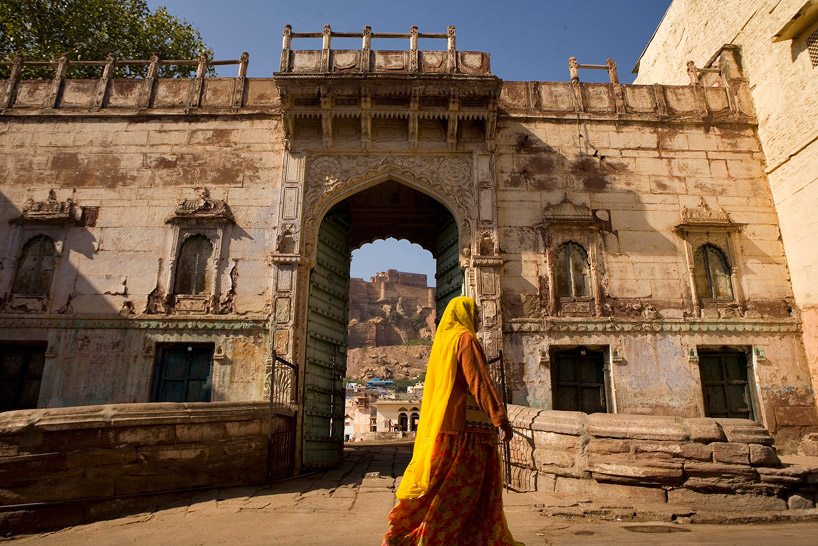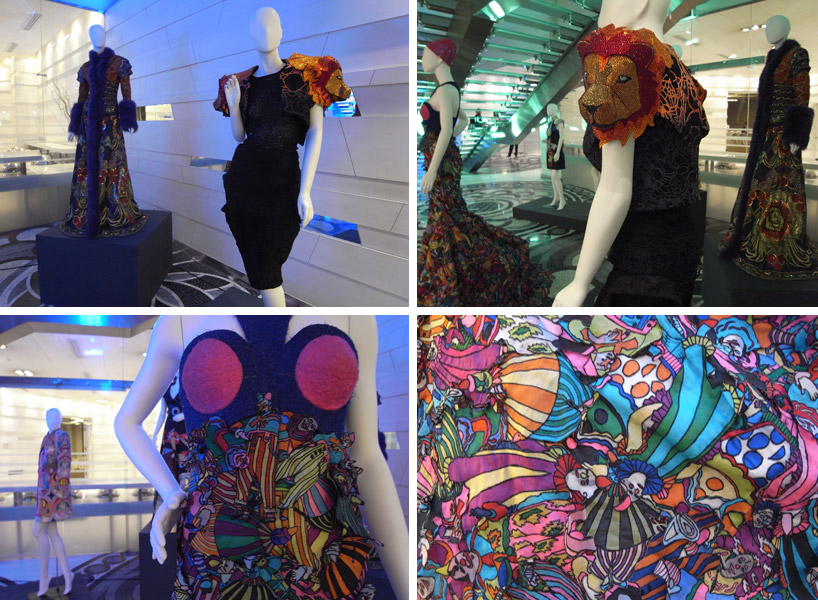from left to right: ambrish arora of india-based architecture firm lotus, spanish designer nacho carbonell, indian designer satyendra pakhale and trend forecasterli edelkoort (all three based in the netherlands) images © designboom
earlier this month, designboom took part in the IDF india design forum, a major conference on the subject ‘the power of design’ and ‘what is the future of design and what role will india play in it?’
india is likely to have a significant impact on design in the 21st century and at the IDF, the main question the indian speakers raised was ‘how can the country draw on its venerable traditions to brand a distinct design identity?’ india will not just consume western products and lifestyles, but it is looking to design as a force for change, and design is being touted both as a tool of economic development and as a means of lifting millions of people out of poverty. this is evident when we look at manufacturers such as tata motors, the producer of the world’s cheapest car — the tata nano. at the same time, many young designers see themselves as a luxury lifestyle creator for india’s new elite and provide smart home interiors.
 from left to right: rajshree pathy introduces the IDF with alex kuruvilla, managing director condè nast india, kamal nath, india’s minister of urban development, and atul punj, chairman of punj lloyd group image © designboom
from left to right: rajshree pathy introduces the IDF with alex kuruvilla, managing director condè nast india, kamal nath, india’s minister of urban development, and atul punj, chairman of punj lloyd group image © designboom
the IDF is co-founded by mother- daughter duo rajshree and aishwarya pathy, and infact, ms. rajshree pathy went ‘knocking on doors’ for sponsors, but was regularly rejected by local industries because the corporate interpretation of design is luxury or fashion and most see little relevance to their own work. the conference’s sponsor list of 40 includes only two manufacturing and infrastructure companies: punj lloyd, a leading engineering group, and titan, a watch manufacturer in the tata group. the other tata companies, such as tata motors and tata steel, and the mahindra and hero companies from the auto industry did not join the group, so did godrej and ITC from consumer goods. ‘the problem’, she says, ‘is that there is no design thinking, in part because the education system is too structured to allow for much creativity.’ the 54-year-old from coimbatore, the town of textile mills, is the newest addition to the list of entrepreneurs churning new businesses out of creativity. she runs her sugar factory in a small village in southern tamil nadu.
‘design is not elitist. phillipe starck’s biography says you need companies that are willing to produce good design in mass production. design is democratic. artist subodh gupta is well known for taking the idea of simplicity in indian utensils to the world. good design means good business and today, modern and contemporary artists enjoy an international following. the country’s manufacturing industry is becoming more and more recognised abroad,’ she continues.
‘people like nehru wanted to design a new india and they brought in people like le corbusier. it was very much the time of socialist movement, there was some thinking. they brought in western architects and under them new schools grew like the ahmedabad school with B V doshi. the IDF was conceived as part of CCoCA, or the coimbatore centre of contemporary arts, which will evolve into a multidisciplinary creative education institute that will include a private art foundation for the contemporary arts and an academy for higher education in architecture, design and the visual arts, based in coimbatore.’
the pathy family hopes to see the ‘made in india’ label replaced by ‘created in india for the world’.
 designboom presents the video ‘save chandigarh’ at IDF india design forum 2012 image © designboom
designboom presents the video ‘save chandigarh’ at IDF india design forum 2012 image © designboom
what did the forum achieve? ca. 700 people participated in the IDF, out of which a third were students. the corporate sector was present as well. among the 50 global thinkers who discussed design, there were architects who focused on addressing sustainable architecture and preserving design heritage like corbusier’s chandigarh. as part of this, designboom presented the film ‘save chandigarh’.
 paola antonelli on the best design proposals in 2011 image© designboom
paola antonelli on the best design proposals in 2011 image© designboom
paola antonelli, a senior curator from the museum of modern art in new york, highlighted the best design ideas of the year. ben hammersley of wired magazine on tech design, and li edelkoort on fashion, were among the diverse range of presenters. see all speakers here.
 ben hammersley of wired magazine image © designboom
ben hammersley of wired magazine image © designboom
we were happy to meet, once again ambrish arora of architecture and interiors firm lotus. he mentioned the importance of sustainability in cities, ‘with contemporary design in public utilities, buildings and infrastructure’.
 ‘raas jodhpur’ by lotus praxis initiative, jodhpur, india image © raas jodhpur
‘raas jodhpur’ by lotus praxis initiative, jodhpur, india image © raas jodhpur
‘manufacturing is cultural participation, and that is exactly the attitude that turned italy, another country with a fine craft heritage, into one of the world’s great design cultures,‘ says satyendra pakhale, india’s renowned product designer, who is currently based in amsterdam. ‘it is a shame,‘ says new york based designer karim rashid, ‘the hotel I stayed at in delhi had italian lighting and furniture, german sinks and faucets, …‘
 graphic designer sujata keshavan image © designboom
graphic designer sujata keshavan image © designboom
bangalore-based graphic designer sujata keshavan stated ‘our products couldn’t look indian because indian products were associated with poor quality.’ she co-founded ray and keshavan, probably the first company in india calling itself a design agency. the comany is well known for the design of the corporate identities of a series of indian airports and many big companies, among them the technology service provider infosys. ‘much of india’s identity comes from its craft tradition, which is a culture of anonymity. in this nation with 16 different languages, names of the architects and master craftsmen behind masterpieces (as the red fort in old delhi) are rarely known.’
 dharmalingam udaya kumar with his rupee design
dharmalingam udaya kumar with his rupee design
dharmalingam udaya kumar had won a nationwide contest run by the government to design a symbol for the indian rupee. the fifth currency to get its own symbol, he designed it by incorporating elements of devanagari and roman scripts. it would be integrated in unicode, computer keyboards will have a dedicated key for the symbol and it will come to be seen and recognised around the world. a designer gets to create a currency symbol just once in a nation’s life — and he made the top crossbar into the country’s flag. d. udaya kumar was born in chennai on 10 october, 1978, and his family hails from thanjavur. he studied architecture at anna university in chennai. subsequently, he did his masters in architecture from IIT, mumbai. when the industrial design centre in the campus started offering a PhD, udaya kumar enrolled, and started work on the evolution of the tamil script, which dates back to 2nd century AD. for the design, he references the symbols of such currencies as korea’s won, UK’s pound sterling, the euro, lira, peso and others.
‘thus it has a harmonious identity as far as international currency symbols are concerned and at the same time it has the indian uniqueness,‘ he said about his winning design. his new job is assistant professor in the department of design at the indian institute of technology in guwahati.
paul austin, the founder of austin advisory group, is a fragrance expert with 18 years of experience with the world’s most innovative fragrance and flavor brands. as head of the fine fragrance division for quest international (now givaudan) until 2008, he spent many years working alongside some of the world’s best perfumers, or ‘noses’, to create scents for iconic brands such as donna karan, thierry mugler, christian dior, estée lauder, serge lutens and narciso rodriguez. in his talk he informed us about the perfume world that is increasingly drawn to the origins and provenance of the natural ingredients used to create fragrances. he spent several months in india studying india’s wide array of natural products used in today’s perfumery: from sandalwood in karnataka to jasmine sambac in madurai.
 fashion design by manish arora, on showat IDF images © designboom
fashion design by manish arora, on showat IDF images © designboom
manish arora is one of india’s most prominent and beloved fashion designers and is also acclaimed internationally. based in new delhi, he was appointed creative director of the womenswear collection at french fashion house paco rabanne in 2011. known for his psychedelic colours and kitsch motifs, arora has been called the john galliano of india.
 fashion design by manish arora, on showat IDF image © designboom
fashion design by manish arora, on showat IDF image © designboom
the IDF has been organized by the colmbatore centre for contemporary art (CoCCA). it is the country’s first and most influential international design platform. IDF started with a design week (2-8 march 2012) which featured movie screenings, exhibitions and workshops around new delhi. the trail ended with a design forum, two days of talks by design virtuosos (march 9-10, 2012) at the le méridien hotel.





